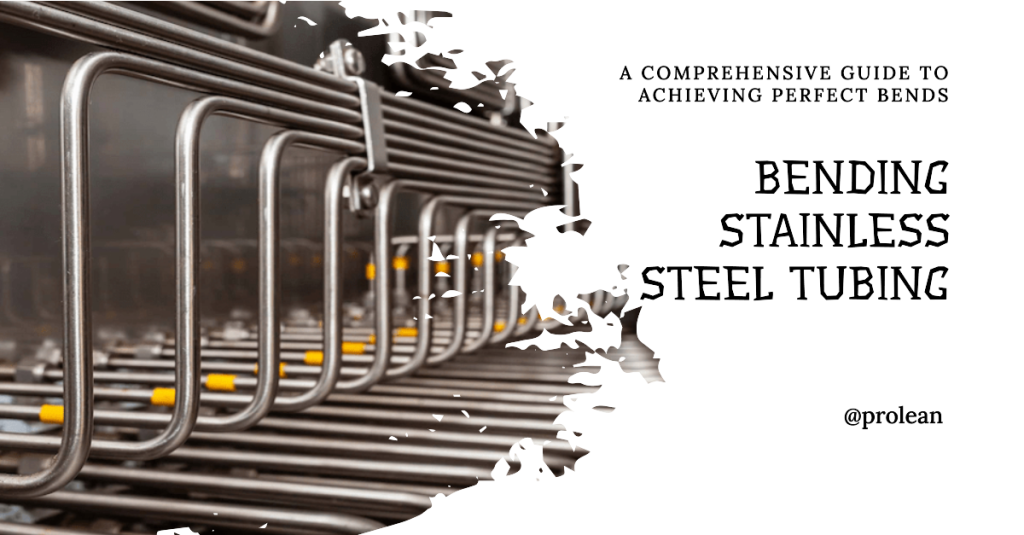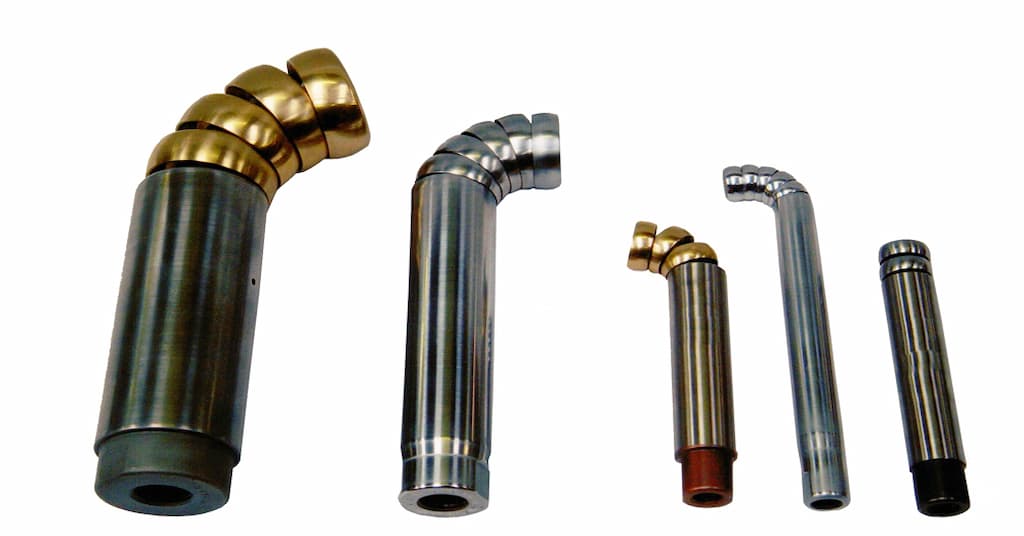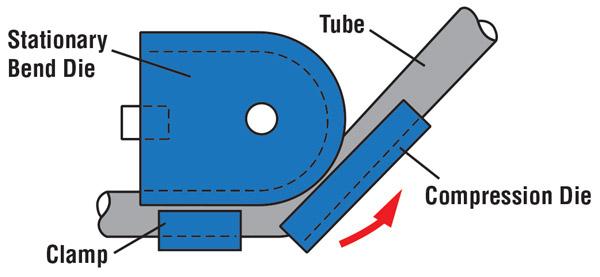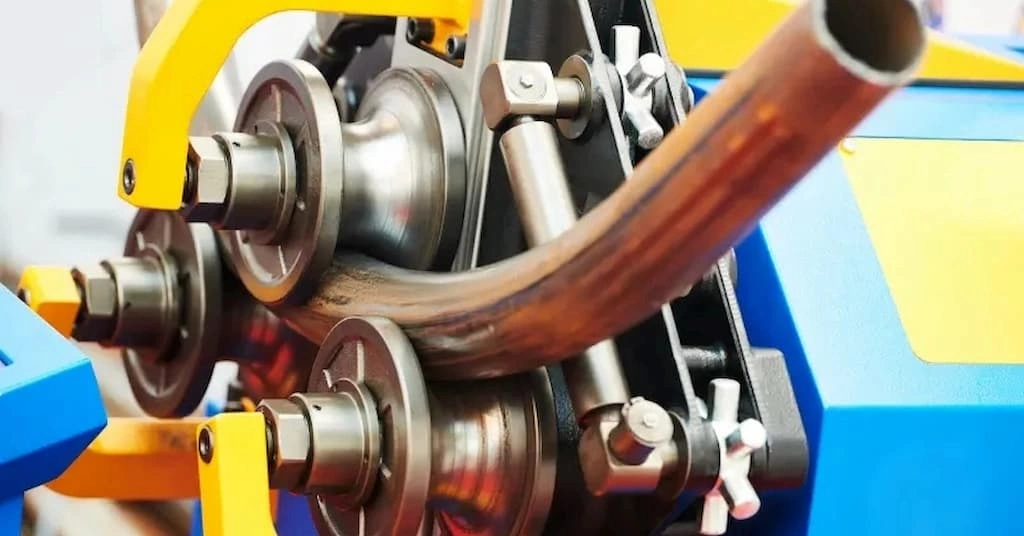“Bending stainless steel tubes demands advanced machinery and skilled operators. Slight errors in design or handelling can cause deformation and stress concentration.”

The stainless steel tubes can be seen in numerous applications, from automotive exhaust systems to medical equipment. They are used in different shapes, sizes, and thicknesses. Bending stainless steel tubing is one of the effective forming techniques for achieving the intended shape of straight tubes. It follows the same fundamental mechanism as Sheet Metal Bending.
High-grade stainless steel’s hardness and other properties make it suitable for bent tube applications. This article will discuss methods, design tips, applications, and bending considerations of stainless steel.
The Geometry of Tube Bending
Before discussing the details of stainless steel tube bending, let’s consider the basic geometry of a typical tube bending process.

Tube bending geometry
- Bend Angle: The angle at which the tube is bent, typically measured in degrees. This angle indicates the deviation from the straight line to the bending axis.
- Centerline Radius (CLR): The distance between the tube centreline and bending curvature center.
- Outside Diameter: This is the total diameter of the tube measured from the outer edge to the opposite outer edge.
Why Stainless Steel for Tubes?
Stainless steel is a strong and highly corrosion-resistant steel alloy composed of 10.5% chromium, 1.2% carbon, and other alloying elements. This composition makes stainless steel highly suitable for tubing applications, as it offers different physical and mechanical advantages.
- Corrosion resistance
- High strength-to-weight ratio
- Non-porous surface
- Durability
- Thermal stability
Moreover, the common stainless steel grades used in tubing are 304/304L, 316/316L, 409, and 430. These grades have distinct properties, suitable for diverse stainless steel tubing applications.
Try Prolean Now!
Methods of Bending Stainless Steel Tubes
Next, let’s elaborate on the methods for bending stainless steel tubing. Manufacturers use distinct methods based on the tube diameter and other bending requirements.
1. Mandrel Pipe or Tube Bending

Mandrel tube bending examples
This method involves inserting a ” Mandrel” inside the tube to avoid the risk of wrinkling or collapsing around the bending position. After inserting the mandrel, the tube is clamped into the bending die that wraps around the pipe rotates. As the die rotates, it bends the pipe around it.
The mandrel inside the tube facilitates the smooth material flow while applying the bending force. So, this tube-bending technique is suitable for tight-bending radii.
2. Compression Tube Bending

Tube compression bending
In the compression bending of tubes, one end of the tube is fixed in the stationary die with the help of a clamp, and the other end remains free. A pressure die mechanism forces the free end into the bending path until the desired curvature is achieved.
The compression stainless tubing bender is suitable for thick-wall and large-size diameters. However, it is less precise and can not create tight bending radii.
3. Roll Bending of Tube

Roller bending of stainless steel tubes
As the name suggests, tube roller bending involves a roller mechanism in which the bedding section of the tube rests. This type of stainless tubing bender typically contains three mechanical rollers with adjustable contours to grip the tube, which can be changed according to square, round, and rectangular tubes. The bender can also fix the bending shape and radius before passing the tube through these rollers.
- Centre Roller: It remains fixed and supports the tube during bending operation.
- Side Rollers: They rotate and deform the tube at the bending position and its surroundings as it passes through it.
This approach to bending stainless steel tubing is widely popular in industrial piping, automotive components, and other areas where thicker tubes are bent. However, roller tube bending is only suitable for Bending Aluminum, steel, copper, and other metals.
Tube Bending Design Tips
The tube bending design is the foundation for any bending operation, no matter which method or technique you apply later. Therefore, considering the right design parameters and dimensions is essential to achieving uniform and quality bending.
Some considerations are slightly different for tube bending as compared to the Sheet Metal Design Guide. The main factors you need to consider during bending designs for stainless steel tubes are thickness, tube size, bending radius, curvature, etc.

Example of 2D tube bending design
Here are the 5 key tube bending design considerations;
1. Consider the design for manufacturing rules if you use a CNC tube bender.
2. The minimum bend radius is half the tube’s outer diameter. But, the slight bend radius is complex and costly.
Min. Bending radius= 1/2D, D refers to the outer diameter of the tube
Standard bending radius=2D
Roll bending min radius= 7D
3. The outer tube wall tends to thin out during the bending process. So check the tinning percentage based on which steel grade you are using and the bend angle.
Wall Thinning(%)=(1− r/R)×100, where R is the tube radius and r is the bend radius.
4. Maintain the minimum tube thickness of 0. 03D to 0.1D, avoid cracks and winking at the bedding point.
Min. tube wall thickness= 0.3D, where D is the tube diameter
5. Consider spring-back for a corrected bend angle (𝜃′=θ+k,) where k is the spring back factor, and its value depends on the material type and tube dimensions.
Try Prolean Now!
Tube Bending Radius Chart
A tube bending chart refers to the systematic arrangement of the relation between tube diameter, bending radius, and thickness for a specific material type. For example, a chart for stainless steel tubing contains a series of tubing diameters and corresponding bending radius and thickness.
Using a tube bending chart in design and bending operations avoids the risk of excess deformation and ensures the material’s integrity after bending.
Tube bending charts are available in different formats: simple rows and columns, graphs, and plots. They can also find the corresponding value for any known parameters, meaning if you have a tube of a specific dimension, you can find the thickness and bending radius achievable. On the other hand, if you have a fixed bending radius, you can check what the permissible tube dimensions and wall thickness are.
Here is an example of a radius chart for bending stainless steel tubing;
Table: Bending Radius Chart for Stainless Steel
| Tubing OD (mm) | Bending Radius(mm) |
| 6.35 | 12.7 |
| 9.52 | 23.8 |
| 12.7 | 12.7 |
| 19 | 28.5 |
| 25.4 | 38 |
| 31.75 | 50.8 |
| 38 | 57.15 |
Courtesy: AXINICS
Applications of Stainless Steel Tube Bending
Have you ever noticed the exhaust pipes of bikes or cars? They are made from bending stainless steel tubes. Although this is one simple application example, the use of bending stainless steel tubing is diverse and widespread across multiple industries. The excellent properties of stainless steel grades and the combined manufacturing capability of bending techniques make this process one of the most effective in tube manipulations.
The applications, examples and benefits of bending stainless tubes are as follows;
Table: Advantages & Application of Stainless Steel Tube Bending
| Application Area | Advantages Stainless Steel Tubing | Application Examples |
| Automotive Industry | Durability in harsh environments, high strength-to-weight ratio, stable thermal properties. | Exhaust pipes, fuel, coolant, brake, Intake manifolds, etc. |
| Construction | Maintenance-free, environmental resistance, and structural integrity. | Supportive columns, handrails, gate frames, decorative trims, etc. |
| Aerospace | High-temperature tolerance, weight reduction, and mechanical strength. | Hydraulic lines, aircraft structural parts, exhaust ducts, etc. |
| Medical Equipment | Hygienic, easy to sterilize, and biocompatibility | Medical bed frames, trolleys, stethoscope tubing, dental tools, etc. |
| Process & Treatment Piping | Chemical resistance, handling high pressures, and ease of cleaning. | Chemical & heat lines, condenser gas transport system, water treatment components, etc. |
Try Prolean Now!
Conclusion
Tube bending methods like mandrel, rotatory, compression, and roller bending are employed to bend the stainless steel tubes. Combining tube diameter, wall thickness, and bend radius is essential for bending stainless steel tubing. The improper thickness or bending radii can cause excessive deformation or even bending failure. Meanwhile, considering other design parameters like wall thinning & spring-back factors are equally important in the process. The proper handling and use of advanced CNC stainless tubing bender can create components for numerous tubing applications, from automotive to piping and treatment plants.
At proleanTech, you can get optimized bending services for your stainless steel tubes. Our Sheet Metal Bending Services encompasses the tubing applications also. Send your design to leverage our advanced manufacturing factory and the experience of our professionals.
FAQs
How do you bend stainless steel tubes?
Bending stainless steel tubes typically involves using a manual or CNC tube bender that contains appropriate dies, mandrels, rollers, or other setups.
Can I bend steel tubes to any bending radius?
Not all bending radii are suitable for steel tubes due to the risk of material failure. There is a fixed range of minimum bending radius based on the material type, tube diameter, and wall thickness.
What are the critical considerations of stainless steel tube bending?
The critical considerations are appropriate bending radius, methods & tools, and the design variables.
What is meant by a tube bending radius chart?
A tube bending radius chart provides guidelines on the minimum radii for bending tubes based on the tube’s material, diameter, and wall thickness.




0 Comments